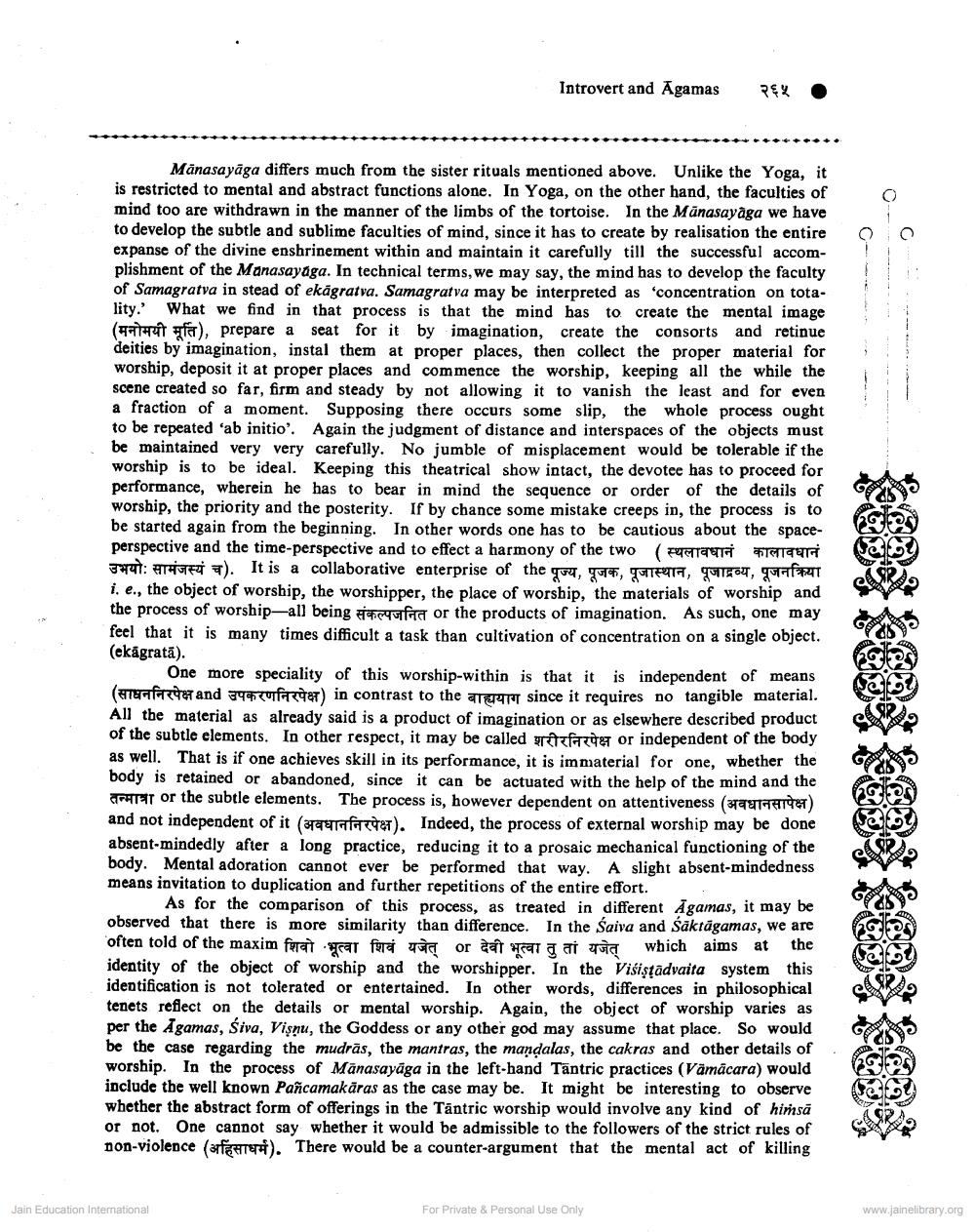________________ Introvert and Agamas 265 . Manasayaga differs much from the sister rituals mentioned above. Unlike the Yoga, it is restricted to mental and abstract functions alone. In Yoga, on the other hand, the faculties of mind too are withdrawn in the manner of the limbs of the tortoise. In the Manasayaga we have to develop the subtle and sublime faculties of mind, since it has to create by realisation the entire expanse of the divine enshrinement within and maintain it carefully till the successful accomplishment of the Manasayaga. In technical terms, we may say, the mind has to develop the faculty of Samagratva in stead of ekagratva. Samagratva may be interpreted as 'concentration on totality. What we find in that process is that the mind has to create the mental image ( TAROT FT), prepare a seat for it by jmagination, create the consorts and retinue deities by imagination, instal them at proper places, then collect the proper material for worship, deposit it at proper places and commence the worship, keeping all the while the scene created so far, firm and steady by not allowing it to vanish the least and for even a fraction of a moment. Supposing there occurs some slip, the whole process ought to be repeated 'ab initio'. Again the judgment of distance and interspaces of the objects must be maintained very very carefully. No jumble of misplacement would be tolerable if the worship is to be ideal. Keeping this theatrical show intact, the devotee has to proceed for performance, wherein he has to bear in mind the sequence or order of the details of worship, the priority and the posterity. If by chance some mistake creeps in, the process is to be started again from the beginning. In other words one has to be cautious about the spaceperspective and the time-perspective and to effect a harmony of the two (FeCOTTET TITTER 37791: FTHUTFI 7). It is a collaborative enterprise of the you, 4010, COPPIA, JO1150t, quafi i. e., the object of worship, the worshipper, the place of worship, the materials of worship and the process of worship-all being cofirst or the products of imagination. As such, one may feel that it is many times difficult a task than cultivation of concentration on a single object. (ekagrata). One more speciality of this worship-within is that it is independent of means (साधननिरपेक्ष and उपकरणनिरपेक्ष) in contrast to the बाह्ययाग since it requires no tangible material. All the material as already said is a product of imagination or as elsewhere described product of the subtle elements. In other respect, it may be called gratefore or independent of the body as well. That is if one achieves skill in its performance, it is immaterial for one, whether the body is retained or abandoned, since it can be actuated with the help of the mind and the TRATAT or the subtle elements. The process is, however dependent on attentiveness (STEETTATO) and not independent of it (378TTTTTT). Indeed, the process of external worship may be done absent-mindedly after a long practice, reducing it to a prosaic mechanical functioning of the body. Mental adoration cannot ever be performed that way. A slight absent-mindedness means invitation to duplication and further repetitions of the entire effort. As for the comparison of this process, as treated in different Agamas, it may be observed that there is more similarity than difference. In the saiva and Saktagamas, we are often told of the maxim शिवो भूत्वा शिवं यजेत् or देवी भूत्वा तु तां यजेत् which aims at the identity of the object of worship and the worshipper. In the Visistadvaita system this identification is not tolerated or entertained. In other words, differences in philosophical tenets reflect on the details or mental worship. Again, the object of worship varies as per the Agamas, Siva, Visnu, the Goddess or any other god may assume that place. So would be the case regarding the mudras, the mantras, the mandalas, the cakras and other details of worship. In the process of Manasayaga in the left-hand Tantric practices (Vamacara) would include the well known Pancamakaras as the case may be. It might be interesting to observe whether the abstract form of offerings in the Tantric worship would involve any kind of himsa or not. One cannot say whether it would be admissible to the followers of the strict rules of non-violence (BIFET). There would be a counter-argument that the mental act of killing a Jain Education International For Private & Personal Use Only www.jainelibrary.org




